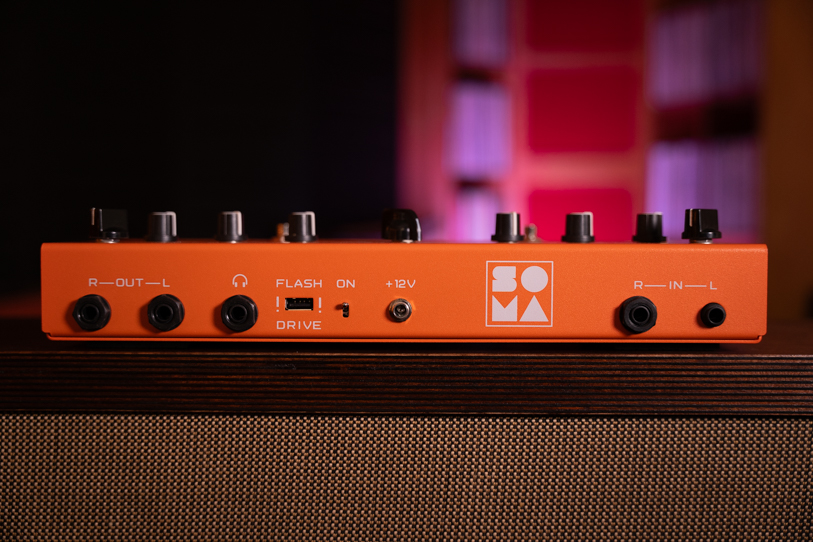SOMA’s newest contribution to the world of ambient music making and expressive synthesis.
We had a dive into something very worthy of a place amongst our many little music making gadgets. We’re checking out the SOMA Cosmos.
Cosmos is SOMAs newest contribution to the world of ambient music making and expressive synthesis. This unit is a drifting memory station. It takes in audio and creates loops which are then processed with delay, reverb, panning and pitch shifting, all of which contribute to a drifting wash of beautiful ambient textures.
Connectivity is pretty simple. The Comos has stereo ¼ inch input and output jacks, a stereo ¼ inch headphone jack and a USB A slot, which we’ll get to in a second.

Before jumping into how the Cosmos sounds it’s important to mention the different firmware modes now offered with this unit. SOMA received a number of user requests to include some more straightforward looping functionality so the Cosmos could be played with more clearly defined tempo and rhythm.
In response SOMA have offered the rhythmic firmware update which can be downloaded from their website. This changes a lot of the functionality of the Cosmos and makes it easier to get under control rhythmically.
What this really means is that between the main firmware and the rhythmic firmware you’re getting two pretty different use cases in the one product.
To perform these firmware updates you’ll need to place the downloaded file onto a usb stick, insert it into the USB A slot of the unit and power it on in its update mode. Because these files are small midi files this process is pretty quick and straightforward.

Let’s start by exploring the main firmware mode of the Cosmos. Here we’re given 4 different delay and reverb algorithms to play with.
The first algorithm which gives you 2 discrete delay lines. Each step on the main knob increases the time between the lines. The second algorithm works the same as the first but this time with 4 discrete delay lines.
The 3rd algorithm is described by SOMA as a massive reverb which increases in size with each setting. The final algorithm is a granular delay, where each setting increases the size of the grain and delay.
Now let’s have a quick talk about the other knobs. The ‘blur’ knob creates crosstalk between the delay lines, blurring the distinction between the left and the right.
The ‘drift’ knob slowly pans delay lines across the stereo field. With the most recent update of the main firmware the drive knob acts as a pitch shifter.

The other settings work more or less as expected. The suppression/compression knob works like a sidechain compressor that ducks the looped internal sounds when a new signal is played.
The feedback and mix knobs work as expected on a delay unit. The unit also has a reverse switch that reverses the delay trails, variable high pass and low pass filters, and of course an erase switch to erase the recorded signals being looped.
Let’s also have a quick chat about the Cosmos with the rhythmic firmware update which allows the device to act more in line with traditional looper, with the mangling options that make the Cosmos so unique.
This rhythmic firmware mode actually has an entirely new user manual with 9 brand new straight and polyrhythmic looping patterns.

Having a play with the Cosmos really lets you create a world that you can get lost in. You can just close your eyes and when you open them again, 4 hours has passed and all the daylight is gone.
Cosmos steers you a little more towards emotional music making. You don’t need to be able to shred to get the most out of it, in fact the simpler you keep your playing, the deeper you’ll sink into the little world you’re building.
I’d love to see a future firmware update that would allow you to switch between the rhythmic and main modes on the fly without having to fuss around with a USB stick.
I suppose time will tell whether this is possible with this unit and if it is, I wouldn’t be surprised if they made it happen. SOMA is still showing it heaps of support post release and they’re clearly listening to their user base.

At 1,350 AUD, the Cosmos is a pretty decent investment, but for those of you out there that make a living creating and performing ambient or art music, this can be the engine room of your performance setup. As for the rest of us, it’s a really nice way to spend your evenings.
Find out more about the SOMA Cosmos from their website: https://somasynths.com/cosmos/
Head to Found Sound to purchase SOMA Cosmos in Australia: https://foundsound.com.au/collections/soma-labs/products/28446


